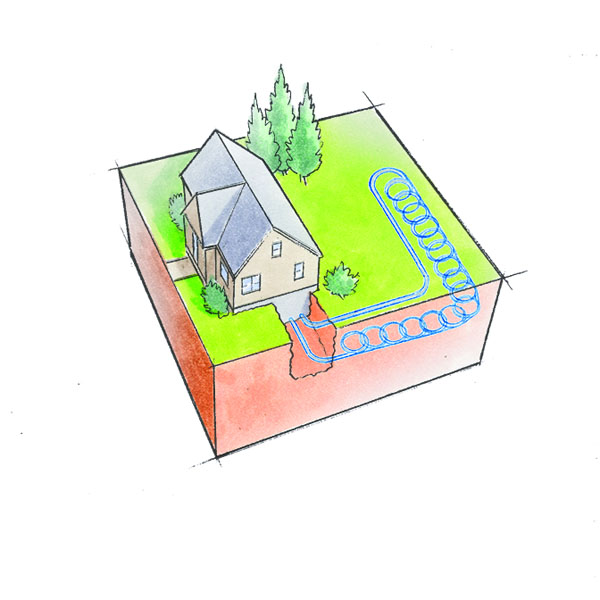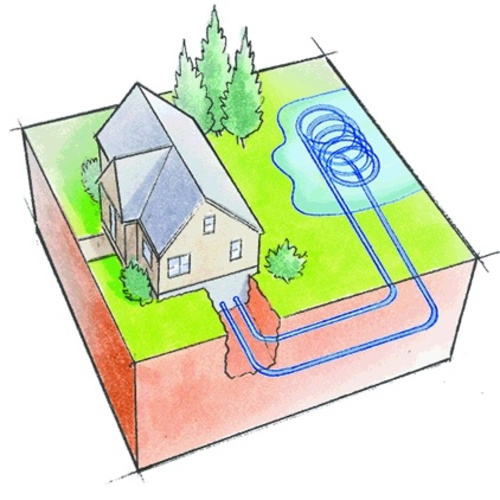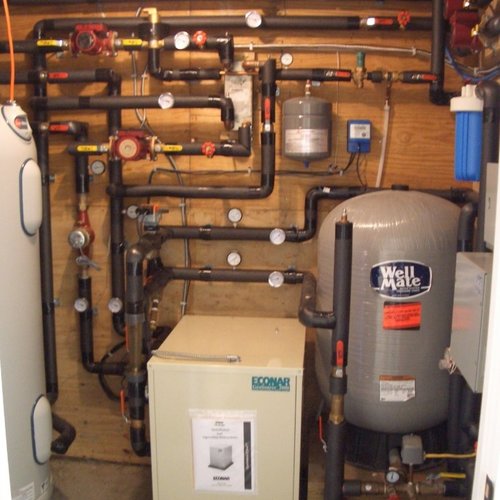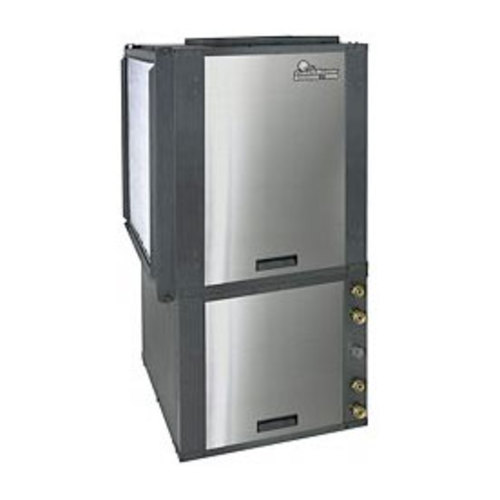
Image Credit: GreenBuildingAdvisor.com
For the past month, I’ve examined various home energy improvements for which one can earn a 30% federal tax credit. The last of these opportunities I’ll cover is ground-source heat pumps. A ground-source heat pump (GSHP) is also referred to as a “geothermal” heat pump, though I prefer the former terminology, to avoid confusion with true geothermal energy systems that rely on elevated temperatures deep underground from the Earth’s mantle. GSHPs are eligible for the 30% tax credit with no cap on the dollar amount that can be received. But this system may not be the best choice for home heating, and I’d like to offer some warnings about the potential for exaggerated claims and outright scams.
GSHPs are pretty amazing systems. Like all heat pumps, they extract heat from one place (in this case, underground) and deliver that heat–at a higher temperature–to your house. That may sound impossible, but it’s how your kitchen refrigerator works. In the summer, heat pumps can be reversed to remove heat from your house, providing air conditioning.
While electric resistance heat is 100% efficient at converting electricity into heat, a heat pump provides at least two to three units of energy for every one unit of energy consumed. This is often measured as the annual “coefficient of performance” or COP; a COP of 3.5 means an effective efficiency of 350%. (Note that if you consider the “source energy” that a power company uses to generate that electricity, the true efficiency numbers are significantly lower.)
In cold climates, a GSHP has higher efficiency than an air-source heat pump (which extracts heat from the outside air), because temperatures underground are considerably warmer in the winter than the outside air. Installing a GSHP involves digging a trench or series of wells into which tubing is embedded. Either refrigerant, water, or antifreeze solution is circulated through this tubing. Another version pulls groundwater from a well as the heat source (or heat sink), and then returns the water to the well.
To earn the 30% federal tax credit, a GSHP must be Energy Star listed. The Energy Star requirements vary by type and are currently as follows: a closed-loop GSHP has to have an energy efficiency ratio (EER) of at least 14.1 or a COP of at least 3.3; an open-loop GSHP must have an EER of at least 16.2 or a COP of at least 3.6; and a direct-exchange (DX) GSHP must have an EER of at least 15 or a COP of at least 3.5.
The reason I’m not a huge proponent of GSHPs is that they’re really expensive. Most of the expense is due to the cost of digging trenches and laying tubing. In addition, field experience shows that these systems often aren’t meeting performance expectations. Sometimes the annual COP turns out to be only slightly higher than 2.5.
Meanwhile, performance of air-source heat pumps–in particular, the ductless mini-split heat pumps that have been popularized by such companies as Mitsubishi, Sanyo, and Daikin–have been improving dramatically in recent years, especially at low temperatures.
In the past, air-source heat pumps only made sense in warmer climates, because the efficiency would drop dramatically at lower temperatures; at about 40°F, these systems would usually switch over to electric-resistance heating. New mini-split heat pumps, by comparison, especially “inverter” models, can function pretty well down to about 0°F. And they cost a whole lot less than GSHPs.
It is not unusual to hear about GSHPs in Vermont costing as much as $35,000 for typical homes. For the same investment, one could spend $30,000 reducing heating loads (insulating, air sealing, replacing windows, etc.) and install a state-of-the-art mini-split heat pump.
The 30% tax credit that’s available for GSHPs allows homeowners to recover some of that very high cost. Air-source heat pumps also earn the tax credit, but only up to $1,500 and only through the end of 2010 (while the GSHP tax credit isn’t scheduled to expire until the end of 2016).
Here’s my concern: Because GSHP dealers can show homeowners how much money they can get back from Uncle Sam (over $10,000 for that $35,000 system), they can make a pretty compelling argument. A few unscrupulous companies might also be tempted to inflate the price of the system–allowing you to earn an even higher tax credit–and then offer you a special rebate or pyramid-marketing inducement of some sort so that both you and the company benefit–at the expense of the rest of us taxpayers.
I don’t have a problem with subsidizing energy improvements through tax credits and other incentives, but if my tax dollars are being spent on these improvements I’d like to be sure that the money is spent wisely. I don’t believe a GSHP costing tens of thousands of dollars is nearly as cost-effective as combining energy conservation and a far less expensive mini-split air-source heat pump.
I invite you to share your comments on this blog.
To keep up with my latest articles and musings, you can sign up for my Twitter feeds
Weekly Newsletter
Get building science and energy efficiency advice, plus special offers, in your inbox.















15 Comments
Good critique, though I hope
Good critique, though I hope the worry about scams is overblown --most installers would be honest.
But you didn't talk about the biggest misperception I see put there with GSHPs: the idea that this is a "clean" energy source, comparable to wind or solar! This fallacy is widespread, and comes up again and again (the idea that the heat is "from the ground"). GSHPs are using electricity, and a lot of it, and therefor are basically coal/nuclear heating systems --but less efficient than burning coal in your house would be (...wouldn't residential-scale nuclear power be awesome! ;) )
dead on but one more point
Oh, I so love to see someone else keeping geothermal and GSHP separate. Another point about them: That vermont house that had a regular furnace probably didn't have air conditioning and didnt need it most of the time. But a GSHP is an air conditioner, and if you give people this, they are going to use it. I would not be surprised if increased AC use negates much of the purported energy savings.
Excellent Perspective
Hi Alex. As usual, your comments are insightful and well reasoned. We all take it as gospel that GSHP's are good systems and part of the solution. In some cases, they may be an optimum response (large, existing homes requiring A/C come to mind). However, as you point out, if you go the next step and compare alternatives, looking into what could be accomplished with the same funds, you will usually find that the more spent on conservation, the better. We all need to continue to push the "reduce use" agenda. Spend enough on the envelope and heat it with waste heat, passive solar, etc.
COP for GSHP
Nice post, Alex. In addition to the concerns you raise, here are two others:
1) the rated COP and EER of ground source heat pumps doesn't include the energy required to pump fluid through the ground loop, or the energy required to power the pump/fan that distributes the heat/cool into the house.
2) In predominantly heating climates, If the heat pulled from the ground is not replaced, you run the risk of lowering the soil temperatures year over year, which will reduce the performance of the system. The reverse would be true for predominantly cooling climates.
For those interested in reading more, here are a couple of good articles/posts from Henry Gifford and John Straub:
https://www.greenbuildingadvisor.com/blogs/dept/green-building-blog/ground-source-heat-pumps-don-t-save-energy
http://www.buildingscience.com/documents/digests/bsd-113-ground-source-heat-pumps-geothermal-for-residential-heating-and-cooling-carbon-emissions-and-efficiency/?searchterm=gshp
does adding solar power change the equation
Thanks for this informative piece. Does adding solar power into the system change the equation? For example if one uses solar power to provide the electricity to drive the GSHP machinery.
What about Heat Pump Water Heaters?
I agree with investing in a better building envelope and going with a mini-split rather than a ground source heat pump HVAC. I hope this is not too far off-topic, but are there any third party evaluations on the efficacy of heat pump water heaters? It would seem that they would be beneficial in hot and hot/humid zones considering the unit exhausts chilled air as it heats water.
Adding PV
Boston,
Energy consultant Andy Shapiro recently helped design the heating and PV systems for a new net-zero-energy gymnasium at the Putney School. He discovered it was cheaper to go with air-source heat pumps (ductless minisplits) with a somewhat larger PV system than to go with a ground-source heat pump and a somewhat smaller PV system.
You don't need a ground-source heat pump, even in Vermont.
Electricity cost will defeat the GSHP
I spent a lot of time researching GSHPs for use in a condominium project being planned. We wanted to use a direct exchange system since we had a large hay field to serve as the exchanger. The heat pumps considered were the Nordic brand, made in Canada and very efficient for cold climates. At the end of the day, the defeating element was the cost of running the ac pumps that drove the system. At 16 cents per kilowatt hour or more, and without being able to utilize any rate reduction in summer for cooling (which is the regulation in Maine), electrically driven heating/cooling systems were simply expensive compared with the same-old, same old method.
Heat pumps will work well provided electricity costs are low, and provided all the other elements of building construction are as efficient as they can possibly be made. Merely shoving a GSHP into an old house and expecting miraculous heating performance in place of the old thumping oil furnace is evidence of delusionary thinking.
GSHP with Solar works for me
I ponied up $41,000 for GSHP ($20,700 after all the credits, etc. here in Marlyand), plus 4kw solar and solar hot water (lots of credits and grants for each of those as well). I also did everything my Energy Audit said to do. Monthly utilities went from $670 (big house with pool, had propane heat before) down to $265. Payback is just over 4 years, then I start really saving. GSHP was part of the solution, and it works great throughout the year. I'm sure there are better solutions, but at least I put my money where my mouth is. If we all wait for the perfect solution, it will always be 'next year'.
PV, air source heat pumps
Martin, thanks for the reply. I'm relatively new to all this. By air source heat pumps are you referring to a product like this?
http://www.energystar.gov/index.cfm?fuseaction=find_a_product.showProductGroup&pgw_code=EP
The following link appears to say such units are better for warmer climates: http://www.energysavers.gov/your_home/space_heating_cooling/index.cfm/mytopic=12620
I'm not sure what the price is, but if I'm understanding you correctly one would add a larger PV system on the roof to provide electricity because the electricity consumption of this kind of heat exchange unit is higher than a GSHP. But the total cost benefit is more positive due to easier installation, along with the improved environmental impact? Also, this system would be recommended for a stand along house?
Ductless minisplits
Boston,
A ductless minisplit is a type of air-source heat pump. Common manufacturers include Daikin, Fujitsu, Mitsubishi, and Samsung. Read more here:
https://www.greenbuildingadvisor.com/blogs/dept/musings/heating-tight-well-insulated-house
This is what I think of GSHP in Upstate NY
The primary concern expressed by RESNET regarding the proposed ENERGY STAR Reference Design, which forms the basis of the prescriptive and performance path, is that it will not meet EPA’s stated policy goal of achieving at least 15% savings with respect to prevailing minimum codes (presumed to be the 2009 IECC). RESNET was particularly concerned about the performance of heatpumps in cold climates and strongly recommended that EPA not allow homes with heat pumps in climate zones 4-8 to qualify through the prescriptive path, but instead require homes with heat pumps to qualify through the performance path.
Geothermal and global warming
Geothermal Heat pumps can transfer heat from a cool space to a warm space, against the natural direction of flow, or they can enhance the natural flow of heat from a warm area to a cool one. The core of the heat pump is a loop of refrigerant pumped through a vapor-compression refrigeration cycle that moves heat.
Variable solutions
Only one discussion mentioned an actual energy cost comparison. All the others provided theory or unquantified data .Am particularly bothered by the lack of comparative data provided by tha alternative
suggestions. Outside of moderate climate locations, most building possess some form of insulation
(most likely not up to present LEED standards, but still there). Would be very interested in data that shows more than 12% savings, based on insulation alone, for an existing building retrofit. What would be the payback time when all retrofit expenses are calculated? Actual numbers would seem to indicate that a
hybrid solution such as better insulation combined with PV and some form of heat pump would be a worthwhile path to explore.
Initial Cost
Author states:
"The reason I’m not a huge proponent of GSHPs is that they’re really expensive. Most of the expense is due to the cost of digging trenches and laying tubing."
If the project is open loop "pump & dump" with shallow well depth, would this still be true?
Log in or create an account to post a comment.
Sign up Log in